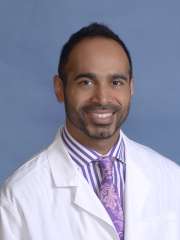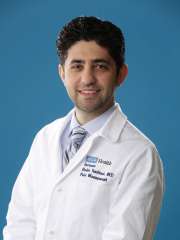Spotlight on Chronic Pain
Written by Lisa Lewis

Chronic pain can be complex, debilitating, and unremitting. By the time patients meet with one of the department’s pain management specialists, either in Santa Monica or at one of six community practices, they may have suffered for many years, including having their pain dismissed or their condition mislabeled.
Each patient comes in with a unique backstory and may present with a constellation of symptoms.
“Anything can come through that door,” said Michael Ferrante, MD, Medical Director of the UCLA Comprehensive Pain Center in Santa Monica.
The diversity within pain management can be overwhelming at first to the fellows, said Dr. Ferrante. “Pain management is very different from traditional anesthesia – it’s much more like an internal medicine practice with an interventional arm.”
Pain management fellows need to learn “a completely different set of pharmacology,” he said, including oral opioids, membrane-stabilizing agents, anticonvulsants, and antidepressants. They also need to understand the pathophysiology of various disease processes that are more neurologically and musculoskeletally based.
“We build on the framework of regional anesthesia and the knowledge of local anesthetics and opioids used in various ways to affect nervous function,” he said. “Then we move on to the use of image guidance, such as fluoroscopy, and then musculoskeletal injections, fascia injections, and ligament injections.”
New interventional procedures
Irene Wu, MD, Associate Director of the UCLA Comprehensive Pain Center in Santa Monica, described the pain management field as rapidly evolving and noted that there have been significant technological advances in the last several years.
Take spinal cord stimulation,” she said. “Ten years ago, patients felt the vibration from the device, but now we can program it so the patients don’t feel that. There have also been advances that allow us to home in more specifically on a patient’s pain area.”
For some patients, spinal cord stimulation has been so effective that they’ve been able to postpone a repeat spinal surgery, she said.
“Where our program really shines is when we can manage their pain with interventional procedures,” she added. This includes kyphoplasty for spinal compression fractures, as well as regenerative medicine using platelet rich plasma (PRP) to enhance collagen growth for shoulder arthritis, rotator cuff issues, or hip or knee pain.
Pain management specialists also offer peripheral nerve stimulation for axial back and neck pain, as well as for joint pain. Other options include minimally invasive lumbar compression (MILD) for patients with central spinal stenosis.
“We’re labeled as chronic pain management, but our expertise is really in interventional pain management,” said Nader Tondravi, MD, who works at the Torrance Lomita Specialty Care Clinic. “We’re a bridge between non-surgery and surgery, meaning that there are a lot of minimally invasive procedures beyond injections that allow patients to get pretty close outcomes to surgery.”
Dr. Tondravi often works with Andrew Vivas, MD, a UCLA neurosurgeon, to determine the best way to address a patient’s pain. “We have a unique referral system within UCLA, where a physician can send a patient to both of us,” Dr. Tondravi said, offering patients “two different unique looks at how we can help their spine pain.”
In addition to offering an alternative to major surgery, minimally invasive procedures can provide relief for patients who may not be good surgical candidates due to age or other illnesses. As an example, Dr. Tondravi cited basivertebral nerve ablation, a new technique that addresses end-plate pain by using radiofrequency energy to apply heat directly to the affected vertebral nerves. The technique provides patients significant relief from back pain without requiring them to undergo a lumbar fusion.
The procedure is currently offered by Dr. Tondravi and by Bi Mo, MD, Interventional Pain and Neuromodulation Specialist at the Thousand Oaks Primary and Specialty Care Clinic, who was the first physician at UCLA to be trained on basivertebral nerve ablation when it was introduced in 2023.
Dr. Mo emphasized that pain management is a demanding subspecialty that requires surgical skills. He and Harkirat Chahal, MD, the two pain management specialists at the Thousand Oaks clinic, both have surgical training in addition to their specialization in pain medicine and often focus on advanced interventional methods, particularly for treating spine pain.
“Every time we go into an operating room, it’s as the surgeon,” Dr. Ferrante added, noting that this is unique within the field of anesthesia.
Expanding the use of existing medications and techniques
While the majority of patients present with back and neck pain, some of the newer minimally invasive techniques that have proven effective for spinal issues are now being used to treat other patients as well.
Both Hayley Osen, MD, who specializes in treating pelvic pain, and Sandra Sacks, MD, who works exclusively with cancer patients, have found spinal cord stimulation to be very effective in addressing their patients’ chronic pain.
“The approach to radiation and the doses have changed a lot in the last couple of decades,” said Dr. Sacks. “We’re seeing patients who continue to have pain despite having their treatment decades ago.” For these patients, spinal cord stimulation can be used to address chemotherapy-related neuropathy, she said.
Similarly, Dr. Osen has found that both spinal cord stimulation and peripheral nerve stimulation “are nothing short of life-changing for patients.”
About two-thirds of her patients are women, she said, and many have been living with chronic pain for months to years. The most common conditions she treats are endometriosis-related and pudendal neuralgia, but she also sees a lot of post-surgical pelvic pain, including in men who have inguinal hernia surgery.
Other patients come to her with issues such as iliopsoas tendonitis, genitofemoral nerve pain, or hip or sacroiliac joint pain. “A lot of times, they’ve been going to a gynecologist or a urologist to deal with what they think is pain in their pelvic area, but it’s a musculoskeletal issue,” she said. “Something like sacroiliac joint pain can cause a lot of groin pain and a lot of pelvic pain. And the gynecologist will see that pain, but they aren’t necessarily thinking about sacroiliac joint pain or have anything to offer for that.”
Treating these patients often takes a multidisciplinary approach, Dr. Osen noted. “From the pain perspective, I focus on minimally invasive interventions, whenever possible. We use nerve blocks, and we can also offer pulse radiofrequency ablation to modulate the pain. Simpler things like trigger point injections and even Botox injections for muscle spasticity are also options,” she said.
“There really hasn’t been enough published about what works for women’s chronic pelvic pain,” she added. “I find myself talking to insurance companies quite a bit about these smaller studies that have been done looking at, for example, superior hypogastric plexus blocks to treat refractory endometriosis pain.”
At the Encino Specialty Care clinic, Parisa Sadoughi, MD, also often turns to newer, less-traditional methods for treating patients’ pain. In particularly, she has found that many patients respond well to what she termed “non-conventional pain management,” using off-label medications including low-dose naltrexone, low-dose ketamine, and memantine. “I do a lot of that in my clinic,” she said. “I’m probably unique in that.”
Taking a broader approach
In many cases, pain management specialists see patients with longstanding pain who have already seen other specialists without finding relief.
“I start by listening to the patient,” said Dr. Osen. “I think it’s really important to hear their full story, in terms of what their pain journey has been, the different things that they’ve tried, and how the pain has changed over the years. I try to understand everything that’s going on with them, because there’s usually more than one diagnosis, and understand the different pieces of their pain.”
Some patients feel like they’ve already been written off or mislabeled, Dr. Ferrante added. “About twice a year, we make a diagnosis of multiple sclerosis. The patient has had very strange symptoms, but nobody thought they could have MS, so they wind up with us.”
There may be a psychological overlay as well, he said. “Pain has a tendency to weave its way through many, many aspects of an individual’s life.”
Dr. Wu noted that the relationship with patients is often an ongoing one, allowing the pain management specialist to modify the treatment plan over time.
“A lot of times, people think of the chronic pain field as medication-prescribing, but the pain landscape is actually quite exciting and continues to evolve new procedures that are more efficacious, with better outcomes and functional improvement compared to being on medication alone.”














